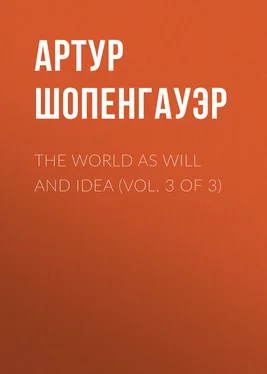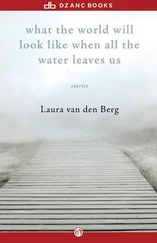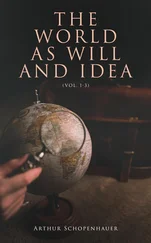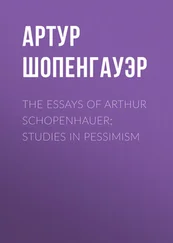Артур Шопенгауэр - The World as Will and Idea (Vol. 3 of 3)
Здесь есть возможность читать онлайн «Артур Шопенгауэр - The World as Will and Idea (Vol. 3 of 3)» — ознакомительный отрывок электронной книги совершенно бесплатно, а после прочтения отрывка купить полную версию. В некоторых случаях можно слушать аудио, скачать через торрент в формате fb2 и присутствует краткое содержание. Жанр: Философия, literature_19, foreign_antique, foreign_prose, на английском языке. Описание произведения, (предисловие) а так же отзывы посетителей доступны на портале библиотеки ЛибКат.
- Название:The World as Will and Idea (Vol. 3 of 3)
- Автор:
- Жанр:
- Год:неизвестен
- ISBN:нет данных
- Рейтинг книги:3 / 5. Голосов: 1
-
Избранное:Добавить в избранное
- Отзывы:
-
Ваша оценка:
- 60
- 1
- 2
- 3
- 4
- 5
The World as Will and Idea (Vol. 3 of 3): краткое содержание, описание и аннотация
Предлагаем к чтению аннотацию, описание, краткое содержание или предисловие (зависит от того, что написал сам автор книги «The World as Will and Idea (Vol. 3 of 3)»). Если вы не нашли необходимую информацию о книге — напишите в комментариях, мы постараемся отыскать её.
The World as Will and Idea (Vol. 3 of 3) — читать онлайн ознакомительный отрывок
Ниже представлен текст книги, разбитый по страницам. Система сохранения места последней прочитанной страницы, позволяет с удобством читать онлайн бесплатно книгу «The World as Will and Idea (Vol. 3 of 3)», без необходимости каждый раз заново искать на чём Вы остановились. Поставьте закладку, и сможете в любой момент перейти на страницу, на которой закончили чтение.
Интервал:
Закладка:
We may attain to an intuitive knowledge of the existence and activity of the will in unorganised nature in quite a different and a sublime manner if we study the problem of the three heavenly bodies, and thus learn more accurately and specially the course of the moon round the earth. By the different combinations which the constant change of the position of these three heavenly bodies towards each other introduces, the course of the moon is now accelerated; now retarded, now it approaches the earth, and again recedes from it; and this again takes place differently in the perihelion of the earth from in its aphelion, all of which together introduces such irregularity into the moon's course that it really obtains a capricious appearance; for, indeed, Kepler's third law is no longer constantly valid, but in equal times it describes unequal areas. The consideration of this course is a small and separate chapter of celestial mechanics, which is distinguished in a sublime manner from terrestrial mechanics by the absence of all impact and pressure, thus of the vis a tergo which appears to us so intelligible, and indeed of the actually completed case, for besides vis inertiœ it knows no other moving and directing force, except only gravitation, that longing for union which proceeds from the very inner nature of bodies. If now we construct for ourselves in imagination the working of this given case in detail, we recognise distinctly and directly in the moving force here that which is given to us in self-consciousness as will. For the alterations in the course of the earth and the moon, according as one of them is by its position more or less exposed to the influence of the sun, are evidently analogous to the influence of newly appearing motives upon our wills, and to the modifications of our action which result.
The following is an illustrative example of another kind. Liebig ( Chemie in Anwendung auf Agrikultur , p. 501), says: “If we bring moist copper into air which contains carbonic acid, the affinity of the metal for the oxygen of the air will be increased by the contact with this acid to such a degree that the two will combine with each other; its surface will be coated with green carbonic oxide of copper. But now two bodies which have the capacity of combining, the moment they meet assume opposite electrical conditions. Therefore if we touch the copper with iron, by producing a special electrical state, the capacity of the copper to enter into combination with the oxygen is destroyed; even under the above conditions it remains bright.” The fact is well known and of technical use. I quote it in order to say that here the will of the copper, laid claim to and occupied by the electrical opposition to iron, leaves unused the opportunity which presents itself for its chemical affinity for oxygen and carbonic acid. Accordingly it conducts itself exactly as the will in a man who omits an action which he would otherwise feel himself moved to in order to perform another to which a stronger motive urges him.
I have shown in the first volume that the forces of nature lie outside the chain of causes and effects, because they constitute their accompanying condition, their metaphysical foundation, and therefore prove themselves to be eternal and omnipresent, i. e. , independent of time and space. Even in the uncontested truth that what is essential to a cause as such consists in this, that it will produce the same effect at any future time as it does now, it is already involved that something lies in the cause which is independent of the course of time, i. e. , is outside of all time; this is the force of nature which manifests itself in it. One can even convince oneself to a certain extent empirically and as a matter of fact of the ideality of this form of our perception by fixing one's eyes upon the powerlessness of time as opposed to natural forces. If, for example, a rotatory motion is imparted to a planet by some external cause, if no new cause enters to stop it, this motion will endure for ever. This could not be so if time were something in itself and had an objective, real existence; for then it would necessarily also produce some effect. Thus we see here, on the one hand, the forces of nature , which manifest themselves in that rotation, and, if it is once begun, carry it on for ever without becoming weary or dying out, prove themselves to be eternal or timeless, and consequently absolutely real and existing in themselves; and, on the other hand, time as something which consists only in the manner in which we apprehend that phenomenon, since it exerts no power and no influence upon the phenomenon itself; for what does not act is not .
We have a natural inclination whenever it is possible to explain every natural phenomenon mechanically ; doubtless because mechanics calls in the assistance of the fewest original, and hence inexplicable, forces, and, on the other hand, contains much that can be known a priori , and therefore depends upon the forms of our own intellect, which as such carries with it the highest degree of comprehensibility and clearness. However, in the “Metaphysical First Principles of Natural Science” Kant has referred mechanical activity itself to a dynamical activity. On the other hand, the application of mechanical explanatory hypotheses, beyond what is demonstrably mechanical, to which, for example, Acoustics also belongs, is entirely unjustified, and I will never believe that even the simplest chemical combination or the difference of the three states of aggregation will ever admit of mechanical explanation, much less the properties of light, of heat, and electricity. These will always admit only of a dynamical explanation, i. e. , one which explains the phenomenon from original forces which are entirely different from those of impact, pressure, weight, &c., and are therefore of a higher kind, i. e. , are more distinct objectifications of that will which obtains visible form in all things. I am of opinion that light is neither an emanation nor a vibration; both views are akin to that which explains transparency from pores and the evident falseness of which is proved by the fact that light is subject to no mechanical laws. In order to obtain direct conviction of this one only requires to watch the effects of a storm of wind, which bends, upsets, and scatters everything, but during which a ray of light shooting down from a break in the clouds is entirely undisturbed and steadier than a rock, so that with great directness it imparts to us the knowledge that it belongs to another order of things than the mechanical: it stands there unmoved like a ghost. Those constructions of light from molecules and atoms which have originated with the French are indeed a revolting absurdity. An article by Ampère, who is otherwise so acute, upon light and heat, which is to be found in the April number of the “ Annales de chimie et physique ,” of 1835, may be considered as a flagrant expression of this, and indeed of the whole of atomism in general. There the solid, the fluid, and the elastic consist of the same atoms, and all differences arise solely from their aggregation; nay, it is said that space indeed is infinitely divisible, but not matter; because, if the division has been carried as far as the atoms, the further division must fall in the spaces between the atoms! Light and heat, then, are here vibrations of the atoms; and sound, on the other hand, is a vibration of the molecules composed of the atoms. In truth, however, these atoms are a fixed idea of the French savants, and therefore they just speak of them as if they had seen them. Otherwise one would necessarily marvel that such a matter-of-fact nation as the French can hold so firmly to a completely transcendent hypothesis, which is quite beyond the possibility of experience, and confidently build upon it up to the sky. This is just a consequence of the backward state of the metaphysics they shun so much, which is poorly represented by M. Cousin, who, with all good will, is shallow and very scantily endowed with judgment. At bottom they are still Lockeians, owing to the earlier influence of Condillac. Therefore for them the thing in itself is really matter, from the fundamental properties of which, such as impenetrability, form, hardness, and the other primary qualities, everything in the world must be ultimately explicable. They will not let themselves be talked out of this, and their tacit assumption is that matter can only be moved by mechanical forces. In Germany Kant's teaching has prevented the continuance of the absurdities of the atomistic and purely mechanical physics for any length of time; although at the present moment these views prevail here also, which is a consequence of the shallowness, crudeness, and folly introduced by Hegel. However, it cannot be denied that not only the evidently porous nature of natural bodies, but also two special doctrines of modern physics, apparently render assistance to the atomic nuisance. These are, Hauz's Crystallography, which traces every crystal back to its kernel form, which is an ultimate form, though only relatively indivisible; and Berzelius's doctrine of chemical atoms, which are yet mere expressions for combining proportions, thus only arithmetical quantities, and at bottom nothing more than counters. On the other hand, Kant's thesis in the second antinomy in defence of atoms, which is certainly only set up for dialectical purposes, is a mere sophism, as I have proved in my criticism of his philosophy, and our understanding itself by no means leads us necessarily to the assumption of atoms. For just as little as I am obliged to think that the slow but constant and uniform motion of a body before my eyes is composed of innumerable motions which are absolutely quick, but broken and interrupted by just as many absolutely short moments of rest, but, on the contrary, know very well that the stone that has been thrown flies more slowly than the projected bullet, yet never pauses for an instant on the way, so little am I obliged to think of the mass of a body as consisting of atoms and the spaces between them, i. e. , of absolute density and absolute vacuity; but I comprehend those two phenomena without difficulty as constant continua , one of which uniformly fills time and the other space. But just as the one motion may yet be quicker than another, i. e. , in an equal time can pass through more space, so also one body may have a greater specific gravity than another, i. e. , in equal space may contain more matter: in both cases the difference depends upon the intensity of the acting force; for Kant (following Priestley) has quite correctly reduced matter to forces. But even if the analogy here set up should not be admitted as valid, and it should be insisted upon that the difference of specific gravity can only have its ground in porosity, even this assumption would always lead, not to atoms, but only to a perfectly dense matter, unequally distributed among different bodies; a matter which would certainly be no longer compressible , when no pores ran through it, but yet, like the space which it fills, would always remain infinitely divisible . For the fact that it would have no pores by no means involves that no possible force could do away with the continuity of its spatial parts. For to say that everywhere this is only possible by extending the already existing intervals is a purely arbitrary assertion.
Читать дальшеИнтервал:
Закладка:
Похожие книги на «The World as Will and Idea (Vol. 3 of 3)»
Представляем Вашему вниманию похожие книги на «The World as Will and Idea (Vol. 3 of 3)» списком для выбора. Мы отобрали схожую по названию и смыслу литературу в надежде предоставить читателям больше вариантов отыскать новые, интересные, ещё непрочитанные произведения.
Обсуждение, отзывы о книге «The World as Will and Idea (Vol. 3 of 3)» и просто собственные мнения читателей. Оставьте ваши комментарии, напишите, что Вы думаете о произведении, его смысле или главных героях. Укажите что конкретно понравилось, а что нет, и почему Вы так считаете.












